The stop sign is one of the most well-known and straightforward safety indications. It is an international symbol that helps control traffic and prevent accidents; it is more than just a red signal on a pole. Understanding what a stop sign means is essential, regardless of your level of experience with traffic signs or your level of education on the laws of the road. For high-quality stop signs and traffic safety products, visit jackwinsafety.com.
What Is a Stop Sign?
At crossroads, road junctions, or crosswalks, a stop sign name is a traffic signal that instructs vehicles to stop completely. It is a designated area where people should exercise caution and keep an eye out for pedestrians and moving cars. When a stop sign appears, it indicates that you should stop, look for any approaching vehicles or people, and only continue when it is safe. Particularly in places with high traffic, such as intersections or close to schools, stop signs alert drivers when it is safe to proceed or cross. They improve traffic management, lower speeds, and lessen confusion.
What Is the Shape of a Stop Sign?
A stop sign’s unique design—an octagon with eight sides—makes the stop sign shape stand out. Stop signs or yield signs frequently use this particular form. When you encounter a sign matching the number eight, even if viewed from behind, it prompts you to halt. Even in bad weather or when their concentration is impaired, drivers can quickly identify the sign because of its eight-sided design. Nonetheless, the form and red color are universal throughout the majority of nations, making it a universal emblem of security.
Types of Stop Signs
Despite their seemingly simple appearance, stop signs come in a variety of forms to accommodate various traffic situations and safety regulations. The main types of indications you might see are listed below:
Standard Stop Sign
This is the typical stop sign that can be seen at many intersections. Drivers must stop completely, keep an eye out for other cars or pedestrians, and only continue when it is safe to do so. These stop signs are usually found on city streets, rural highways, and residential areas.
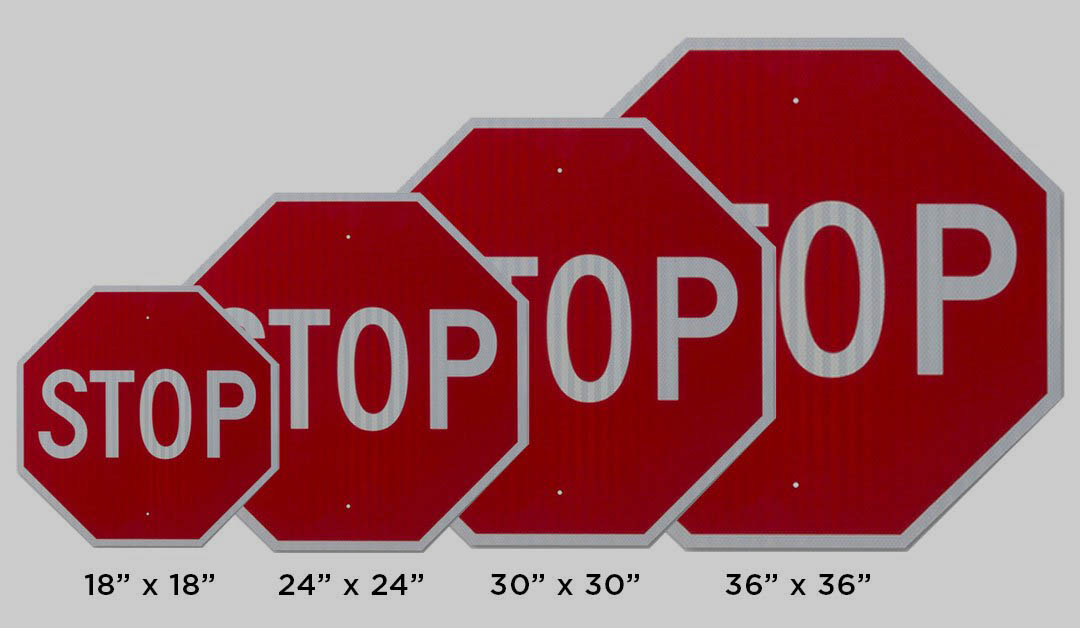
Four-Way Stop Sign
There is a stop sign on every road at a four-way stop. Every nearby car has to stop. The first car to arrive gets to go first. The car on the right has the right-of-way if two cars arrive at the stop signal at the same time. These signs are commonly found at intersections close to traffic signals.
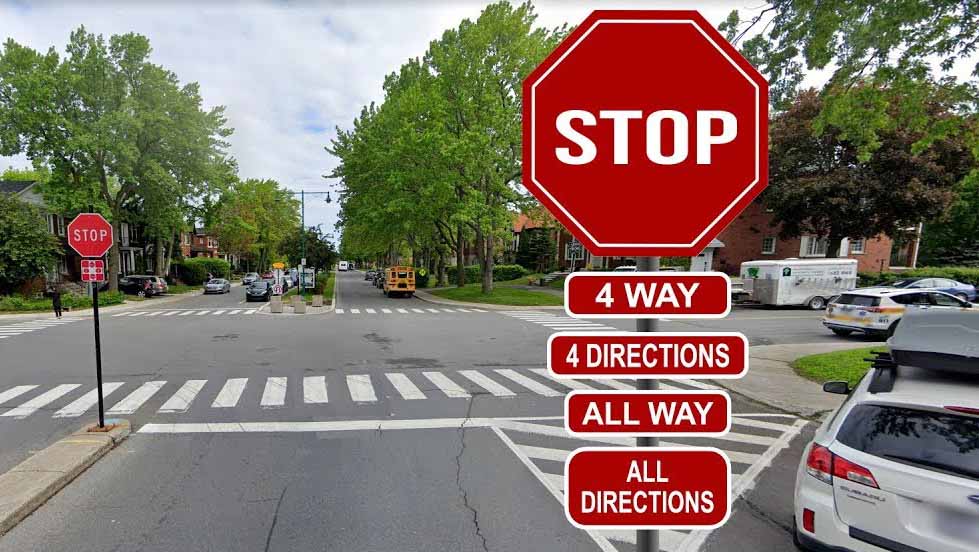
Two-Way Stop Sign
Things might get complicated in situations when there are just two signs telling cars to stop, but traffic on the main road keeps moving. At stop signs, drivers need to remain aware of the cars on the main road. By enabling some routes to handle a larger number of vehicles or be utilized more frequently than others, this configuration aids in traffic control.
All-Way Stop Sign
Although this type is less important at more complicated intersections where four highways converge, it does complement a four-way stop. Every driver must stop and follow the same guidelines when crossing or moving forward at a crossroads where several routes merge.
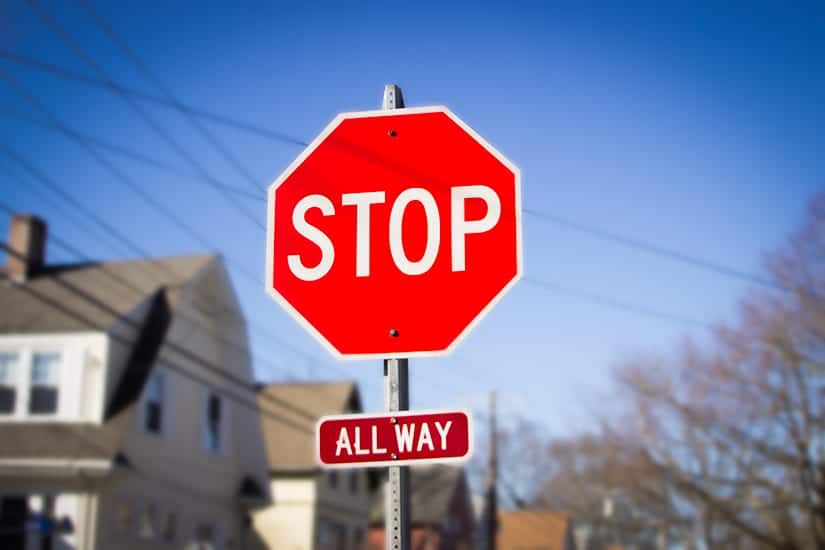
Stop Sign that Flashes
These signs are visible at night and in inclement weather because they include attention-grabbing flashing lights. To improve safety, flashing stop signs are frequently placed in high-risk locations like school zones, busy intersections, or construction zones.
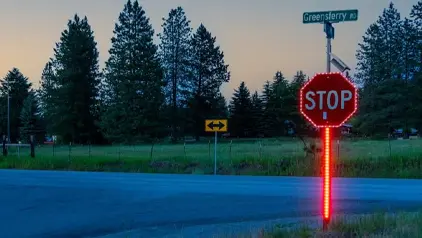
Stop Slow Sign with Handle
These signs with handles we called stop slow signs. In the United States, people call them “stop slow sign paddle”. They also have a version operated by a rechargeable battery, called “LED flash stop slow paddle”. But in Australia, people call it “stop slow bat”.
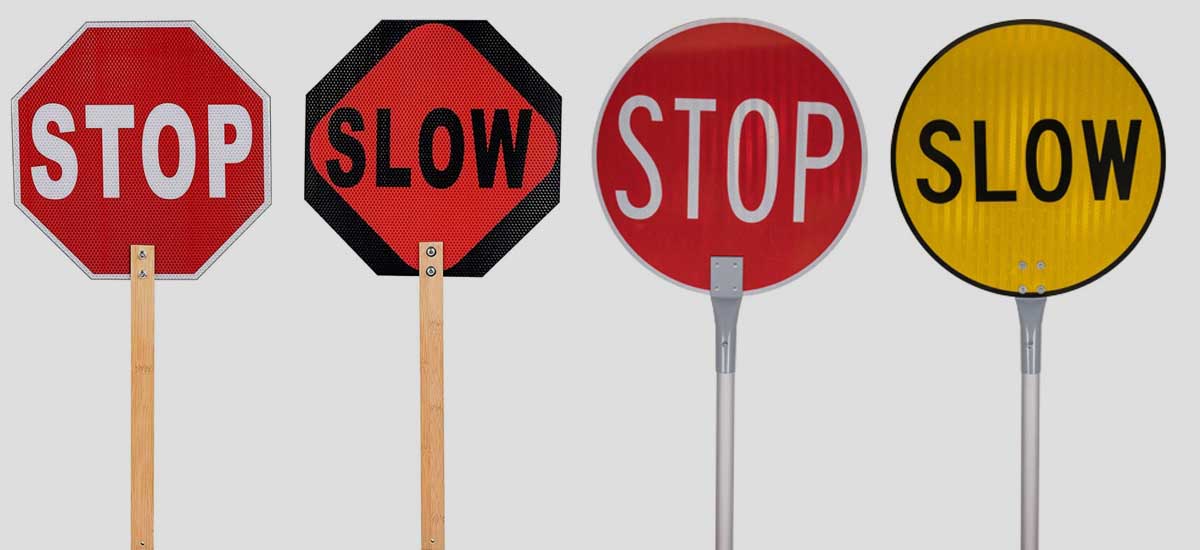
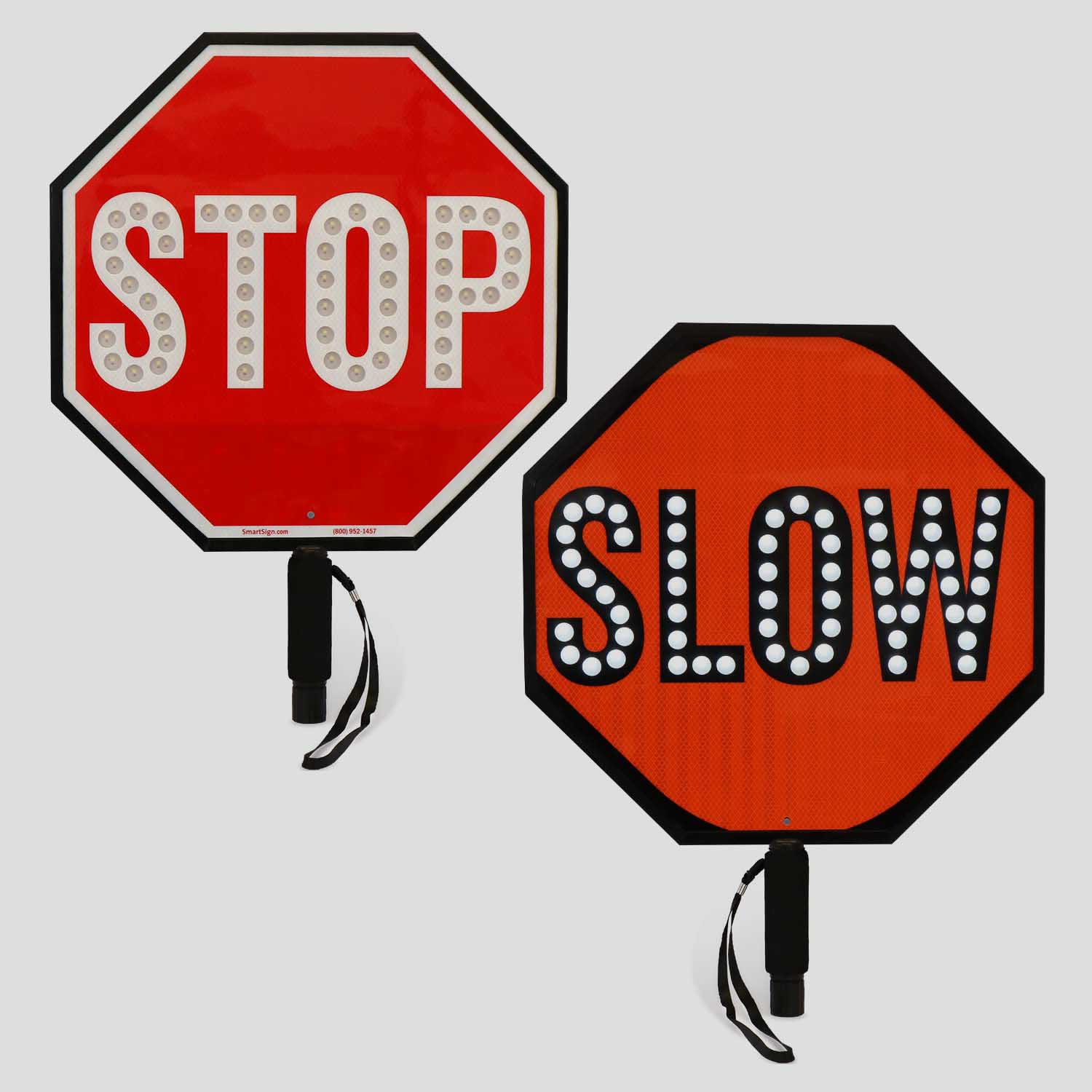
Where Are Stop Signs Used or Stop Sign Purposes?
There are plenty of stop sign purposes that make them very important in modern traffic rules. Let’s understand some prominent areas of applications.
At Intersections Without Traffic Lights
At crossroads without traffic signals, you usually see a stop sign traffic sign. By indicating when cars should cross or continue, these signs help to prevent miscommunications and collisions. They are especially important in areas where it is difficult to see approaching cars.
In Residential Neighborhoods
Stop signs are commonly placed in residential areas to reduce vehicle speed and improve pedestrian safety, especially for kids playing and dog walkers. At local intersections, they make sure that vehicles exercise caution.
Near Schools and School Zones
Stop signs are frequently erected near schools and school zones to control traffic and guarantee student safety. In order for people to cross the street safely, especially during school hours or when traffic surrounding educational institutions increases, helpers must stop vehicles.
At Pedestrian Crossings
Stop signs are placed at pedestrian crossings in busy places, such as city streets and well-known parks, to make sure that cars are aware of pedestrians. This arrangement promotes safer street crossings and lowers the chance of accidents.
At Railway Crossings
Stop signs may be erected at train crossings in the event that automatic gates or signals are not available. This guarantees that before continuing, vehicles will stop and look for any trains that may be approaching.
In Parking Lots and Commercial Areas
Stop signs are frequently used in parking lots and commercial areas to control vehicle movement and reduce the risk of accidents in vast parking areas seen in shopping malls, shopping centers, or event venues. These signs help vehicles in places where there is a lot of foot traffic and odd activity.
In Construction or Work Zones
In order to safely manage traffic around the building site, temporary stop signs are also used. When road changes or detours are required, they help prevent accidents, especially for the construction personnel and supplies.
At Private Roads and Exits
Stop signs are commonly placed near the entrances of private locations that open to public streets, such as school grounds and new communities. This facilitates a secure shift into more congested traffic situations.
In Rural or Low-Traffic Areas
Stop signs are occasionally placed at crossroads in low-traffic areas to remind vehicles to slow down, especially in areas with poor visibility or unusual road designs.
Regular Stop Sign Dimensions/Measurements
1. Standard Height in Urban Areas
The traditional stop sign used in the United States is 30 inches (76 centimeters) across. This measurement is the distance between the immediately opposing sides of an octagonal form. The height was chosen especially for the majority of residential streets and city roads since it makes it easy for cars to see it without being overpowering to the surrounding area.
2. The Perfect Size for Multi-Lane or High-Speed Stop Signs
Having well-placed stop signs that are visible from a distance is essential in areas with higher traffic speeds or more winding roads. A typical stop sign is 36 inches (91 cm) wide and is utilized at busy junctions or in places that need better visibility because of heavy traffic.
However, a stop sign that is 48 inches (122 cm) wide is not appropriate for highways or roads with higher speed limits. Drivers can react cautiously and stop in time because they can see these larger signals sooner. These rules make it easier for drivers to see and respond to signs, especially when they are traveling faster.
3. Thickness and Material of Stop Signs
Typically, stop signs are made from metal as it resists rust and is sturdy. Depending on where they are placed and the materials they are made of, these signs may vary in thickness. 0.080 inches, which is smaller; 0.100 inches, which is one-tenth of an inch; and 0.125 inches, which is one-eighth of an inch, are some examples of standard widths. Signs that are thicker are usually more durable and are usually positioned in areas that are vulnerable to severe weather or high winds.
4. Mounting Height of a Stop Sign
To guarantee sight for everyone, even those in larger vehicles like trucks, buses, or lower-profile cars, the height of a stop sign from the ground is measured. In metropolitan environments, the stop sign’s base needs to be at least 7 feet (2.13 meters) above the ground.
This height guarantees unobstructed vision in congested urban settings by avoiding impediment from parked cars or people. The signage must be prominently displayed at least five feet (1.52 meters) above the ground in rural areas. Clarity is maintained, and needless restrictions are avoided at this somewhat lower height.
Recommended Stop Sign Rules For Height
1. Standard Height in Urban Areas
A stop sign’s placement is essential because it allows cars to see it and gives them enough time to stop safely. In the US, the Manual on Uniform Traffic Control Devices, or MUTCD, provides comprehensive instructions for stop sign placement based on local conditions and environmental characteristics. Obstacles, including parked cars, construction zones, and pedestrians, are frequently more prevalent in urban settings.
The stop sign’s lowest position needs to be at least seven feet (2.13 meters) above the ground. Even in poorly maintained regions, vehicles can quickly identify the sign and follow the stop requirement due to its height, which helps make it visible above a variety of road impediments.
2. Standard Height in Rural Areas
In general, visibility problems are less common, and traffic is generally lighter in rural areas. Therefore, in these situations, stop sign height must be at least five feet (1.52 meters) high. Visibility in the surrounding area is improved by this lower positioning.
For drivers, it makes navigation simpler and reduces problems. Whether in an urban or rural stop sign location, a stop sign should always be at least 7 feet (2.13 meters) above the ground when it is placed next to a road or path. This guarantees that the sign will always be visible to everyone and that pedestrians will not be blocked.
3. Height on Elevated Surfaces & Sidewalk Clearance
The height is measured from the base underneath the sign rather than the upper edge of the curb in certain situations, such as when a stop sign is situated on an elevated curb or surface. This method ensures consistency and unobstructed sightlines, suggesting that, independent of elevation, there should be seven height requirements in urban areas and five in rural areas.
All vehicles can see a stop sign when it is positioned at the proper height. This lowers the possibility of accidents brought on by missed or improperly placed signs and ensures that all drivers can easily understand and follow the same traffic laws.
Why Stop Signs Placement Matters
Stop signs are more than just red octagons at intersections; they are essential for maintaining street order and everyone’s safety. Stop signs are there for a reason, whether you are walking down a busy metropolitan street, a quiet neighborhood, or a school zone. Despite their seemingly simple appearance, they play a crucial role in traffic management and collision avoidance.
-
Promoting Safety at Intersections
Stop signs’ function in regulating traffic at intersections is a major factor in their significance. Stop signs ensure that drivers stop and look before navigating bends or crossroads in areas without traffic lights. Particularly in places without traffic control, this approach dramatically lowers the chance of accidents that usually happen when cars strike from the front or side.
-
Protecting Pedestrians and Cyclists
Additionally, stop signs serve a key role in safeguarding the most vulnerable road users, such as pedestrians and bicyclists. These signs provide people on foot or on bikes a safe chance to cross the street or quickly change their course to escape drivers’ unexpected actions by requiring cars to stop completely. This degree of traffic control is especially important in places that are developing new parks, schools, or residential neighborhoods.
-
Maintaining Order and Right of Way
Stop signs help people know when it is safe to advance or cross the roadway at busy or difficult intersections. Drivers may find it difficult to determine who should go first in the absence of appropriate legislative frameworks, which could cause misunderstanding or accidents. The regulations of the road are generally established by stop signs: whoever gets there first goes first, or waits for the right-of-way.
-
Reducing Speed in High-Risk Areas
Stop sign images are useful for reducing speed in residential areas, next to educational facilities, and in regions that are undergoing construction. A stop sign forces people in control to slow down and pay attention, even when automobiles are traveling at high speeds. This improves safety for workers, homeowners, and kids in addition to reducing the likelihood of collisions.
-
Maintaining Easy Traffic Movement in Limited Areas
Stop signs offer an economical and effective way to control traffic in areas where studies do not support the necessity for traffic lights. They nonetheless permit boats to move freely, which is a sign of safety, especially in areas with poor visibility or where highways cross at odd angles.
-
Encouraging Driver Awareness
Drivers can interact with their surroundings more completely when they are aware. It helps to stay aware of your habits, check your mirrors frequently, pay attention to other drivers, and make better choices. As a result, stop signs also have a psychological effect by reminding drivers to pay attention and not just drive fast through intersections.
Sum Up
In summary, the stop sign represents caution, respect, and shared duty on the road and is more than just a typical octagonal design. Are you prepared to improve safety in your group or community? Whether you require durable stop signs, personalized traffic signs, or entire traffic signal solutions, we have you covered. Our signs are made to be as visible as possible, long-lasting, and completely compliant with safety standards.
When it comes to safety, do not compromise; place your order with us directly for premium goods at affordable costs with prompt delivery. To locate just what you need to maintain the safety and orderliness of your roads, streets, and paths, contact us immediately or peruse our catalog.
FAQS
How Many Sides Does a Stop Sign Have?
A stop sign is an eight-sided figure because it has eight sides.
Where are Stop signs posted?
In order to control traffic and lower the chance of accidents, stop signs are usually erected at junctions, pedestrian crossings, and high-risk locations.
What are the colors of a Stop sign?
The stop sign is a well-known warning and alerting device that is red with a white emblem.
What does a Stop sign mean?
It tells you to stop completely, check for cars or pedestrians, and only go forward when it is safe to do so.
What type of sign is a Stop sign?
As a regulatory sign, a stop sign is used to enforce traffic laws and guidelines.


-80x69.png)

